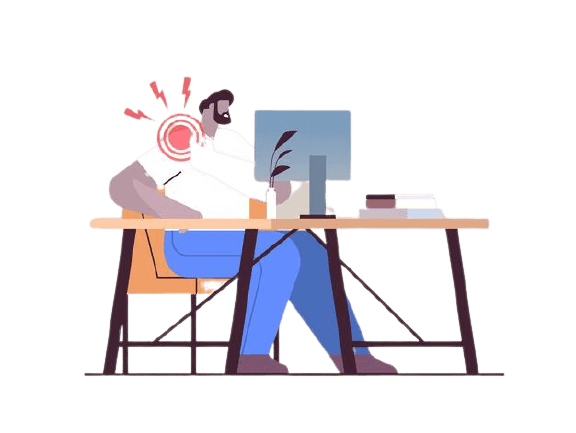Shoulder pain treatment online | Online Physiotherapy Clinic
- Affordable and reliable Shoulder pain treatment
- Video sessions with expert Physiotherapists/ PTs.
- Specialized physical therapy for Shoulder pain, sprain, bursitis, or stiffness
Begin Therapy
Consult online with best Physios
A New Model for Shoulder Pain Treatment
We understand that it’s difficult for most of us to find time for traditional Shoulder physical therapy. Physio Mantra brings to you online Shoulder pain treatment, where all Shoulder exercises and treatments are managed through regular online check-ins & video sessions.
Expert Physical therapists
Physio Mantra members get matched with a professional physiotherapist for one-on-one Shoulder pain treatment. They use interactive exercise videos available on our app to treat you.
Continuous Medical Care
Physio Mantra physiotherapists are 100% virtual and provide physical therapy to patients without any time and geographical barriers. Our technology-enabled approach helps manage physical ailments from head to toe.
Personalized Shoulder Pain therapy
Physio Mantra provides everyday exercises, home remedies, and regular check-ins for all your Shoulder pain physiotherapy needs. We individualize treatment for each person, with problems including Shoulder pain, muscle injuries, sprain, bursitis, stiffness, and more.

Best Shoulder Pain Clinic, Now In Your Pocket
Our physical therapists or PTs are available in all parts of the world via an easy-to-use mobile application. The use of artificial intelligence, and data science enables the patients to connect with expert physiotherapists and get real-time insights into their Shoulder health. Download PhysioMantra App Now

How it works

Signup for our Shoulder Treatment Program
Just fill up a 5-minute online form to tell us about your Shoulder pain history and treatment expectations.

Meet your PT
We will connect you with a physiotherapist who is available 24/7 to you via call or chat.

Connect to our app
Get Physical Therapy sessions on our app via video calls. Follow exercises suggested by our PT and track your progress in the app.
Meet the best online physical therapist
MantraCare physical therapists treat muscle and joint pain problems through a combination of body exercises, video demonstrations, and a healthy diet. Our treatment experience is a better traditional in-person approach in multiple ways.

Dedicated Physio
You get a personal Physio who customizes the exercise plan based on your comfort and needs

App-guided Exercises
3D animations & voice narrations in our app ensure proper and right guidance

Expert care anywhere, anytime
With over 200+ physios, MantraCare is 100% online – no waiting rooms

Exercise Kit
Complete exercise kit with elastic bands, door anchor, and a phone stand – mailed to you
A Complete Guide On Shoulder Pain Physiotherapy
Understanding Shoulder Pain
Shoulder pain is one of the most common types of pain, and it can occur for a variety of reasons. The shoulder is a complex joint that’s made up of muscles, tendons, and bones, so there are many potential sources of pain.
This pain can range from mild to severe and may be caused by a variety of factors, including overuse (such as in athletes), injury or trauma, arthritis, and more. Shoulder pain is also very common in older adults due to the loss of muscle mass that occurs with aging.
If your shoulder hurts, it’s important to know what kind of pain you’re feeling so you can figure out how best to treat it. Some types of shoulder pain are temporary and will go away on their own without any treatment; others require medical attention for proper diagnosis and treatment plan development.
Types of Shoulder Pain
There are many different types of shoulder pain, but some of the most common include:
Acute Shoulder Pain
Acute shoulder pain is the most common type of shoulder pain and is caused by an injury or trauma. This type of pain usually lasts for a short period of time (a few days to weeks) and typically goes away with treatment. This also includes pain that’s caused by overuse, such as in athletes.
Chronic Shoulder Pain
Chronic shoulder pain is a type of pain that lasts for more than three months and is usually the result of an ongoing injury or condition, such as arthritis. This type of pain can be very debilitating and may require treatment with medication or surgery.
Sudden Onset Shoulder Pain
Sudden onset shoulder pain is exactly what it sounds like – sudden, severe pain in the shoulder joint that comes on suddenly. This type of pain can be caused by many different things, from a traumatic injury to a medical problem like a heart attack.
Signs of Shoulder Pain
There are main signs and symptoms of shoulder pain, which can vary depending on the cause. Some common signs and symptoms include:
Swelling
Swelling is often a sign of inflammation, which is common with many types of shoulder pain. This swelling may be localized to the shoulder joint or occur throughout the arm and hand.
Tenderness
The shoulder is a very sensitive area, so tenderness is often one of the first signs of pain. You may feel pain when you touch or move your shoulder, especially if there’s an injury involved.
Aches and Pains
Aches and pains are other common symptoms of shoulder pain. You may feel pain in the shoulder itself, but it can also radiate down the arm and into the hands and fingers.
Reduced Range of Motion
If you have chronic shoulder pain, you may experience a reduced range of motion in the joint. This means that you’ll have difficulty moving your arm in certain directions or extending it out to the side.
Numbness or Tingling
Numbness or tingling in the arm and hand can be a sign of nerve compression, which is often caused by conditions like arthritis. This symptom can vary in intensity and may come and go over time.
Causes of Shoulder Pain
There are many different causes of shoulder pain, and they can vary depending on the person. Some common causes include:
Injury or Trauma
Injury or trauma is a very common cause of shoulder pain, especially in athletes. This may be due to a direct blow to the joint, such as from a fall or car accident, or from overuse. This type of pain typically resolves on its own with time and treatment.
Arthritis
Arthritis is a condition that causes inflammation and pain in the joints. This can occur in any joint in the body, but it’s most common in the shoulder, hips, knees, and hands. Arthritis can cause chronic shoulder pain that may require treatment with medication or surgery.
Poor Posture
Bad posture is often to blame for chronic shoulder pain. When you slouch or hunch over for long periods of time, it can put stress on the muscles and joints in the upper back and shoulders, leading to pain over time.
Muscle Strain
A muscle strain is often caused by overuse or repetitive motions and can lead to acute or chronic shoulder pain. This type of injury can occur anywhere in the arm muscles but typically affects the rotator cuff muscles.
Treatment of Shoulder Pain
There are many different treatments for shoulder pain, and they can vary depending on the cause. Some common treatment options include:
Physical Therapy
Physical therapy is often recommended for people with chronic shoulder pain caused by conditions like arthritis or a rotator cuff injury. Physical therapy helps strengthen muscles and improve the range of motion in the joint. It may also help relieve inflammation and swelling that’s contributing to your symptoms.
Anti-Inflammatory Medication
Over-the-counter anti-inflammatory medications like ibuprofen (Advil) or naproxen sodium (Aleve) can be used to treat acute shoulder pain due to an injury or trauma. These drugs work by reducing inflammation in the affected area, which relieves pain and swelling.
Surgery
In some cases, shoulder pain may be caused by a medical condition that requires surgery to treat. For example, if you have arthritis in your shoulder joint or a torn rotator cuff tendon, then surgical treatment may be recommended. Surgery can help relieve symptoms and improve the range of motion in your arm over time.
Physiotherapy For Shoulder pain
Physiotherapy is one of the best solutions for shoulder pain. You should do it as soon as it starts to hurt because the longer you wait, the worse off you’ll be and you won’t get better without doing something about it.
If your shoulder is hurting for more than a week or two, it’s time to see a physiotherapist! They can help with any type of shoulder problem from bursitis and tendonitis to frozen shoulder syndrome (adhesive capsulitis).
Physio will work on strengthening muscles around joints so that they don’t become weak over time which causes problems like arthritis in older people who haven’t taken care of their bones when younger.
Physio can be extremely beneficial for shoulder pain, whether it’s chronic or acute. Physios will work with you to improve your range of motion, reduce inflammation and swelling and strengthen the muscles around the shoulder joint. This can help to relieve your pain and get you back to your everyday activities as soon as possible.
Different Types of Physiotherapy For Shoulder Pain
There are many different types of physiotherapy that can be used to treat shoulder pain.
Active exercise
These work the muscles around your shoulder and help you regain movement and strength in it. The physio will guide you through a set of movements to improve flexibility, strengthen the muscles around your joints, reduce stiffness in them and restore normal function. Exercises include stretching for better range of motion, rotator cuff strengthening using hand weights or elastic bands (when pulling on these bands against resistance), scapular stabilization (to steady the bone attached to your upper arm), and improving posture by engaging core muscles.
Passive exercises
Here, the therapist guides you through stretches without any active involvement from you – he or she carries out all necessary movements. This may be used alongside active exercises, or on its own, and is usually recommended for people who have a lot of pain and very limited range of motion.
Cryotherapy
This involves applying ice packs to the shoulder area to reduce inflammation and swelling. It’s typically used soon after an injury has occurred, or in cases of chronic pain.
Ultrasound
This treatment uses high-frequency sound waves to help heal damaged tissues. It’s often used for conditions such as rotator cuff tears, bursitis (inflammation of a fluid-filled sac that cushions the joint), and tendinitis (inflammation of a tendon).
Benefits of Shoulder Pain Physiotherapy
There are many benefits of shoulder pain such as:
Relieves Pain and Inflammation
This is the number one benefit of physiotherapy for shoulder pain. Physios will work to reduce inflammation and swelling in the joints, which can help to relieve your pain and make it easier to move your arm.
Improves Range of Motion
If you have a limited range of motion due to a rotator cuff injury or other condition, physiotherapy can help improve this. Physios will work with you to stretch and strengthen the muscles around the shoulder joint, which can help improve your range of motion over time.
Strengthens Muscles
Physiotherapy can also help strengthen the muscles around the shoulder joint. This can not only help relieve pain but also prevent future injuries from occurring.
Reduces Stress on Joints
When you have strong muscles surrounding your joints, it helps to reduce the amount of stress that’s placed on these areas. This can be beneficial for people with conditions like arthritis, as it can help to reduce pain and inflammation in the joint.
10,000+ Happy shoulder Pain patients from the world

“I’ve had an injured shoulder and it was really painful before seeing my physio! The exercises she gave me have made such a difference over time – even though I don’t do them as often now because of my work. Physio Mantra is one of the best place to find the best physiotherapists. ”
Kamya, 3 Months at MantraCare
Best physiotherapist from across the world





We treat nearly all muscle and joint issues
Not all physical or muscle problems are the same. Different types of problems require different treatments. At MantraCare, 200+ physical therapist the world cover a range of specialties to meet your needs be it back pain, shoulder pain, or sports injury:
Frequently Asked Questions
Physiotherapy is not just about exercise, but can also include other treatments such as massage, heat and cold therapy, ultrasound treatment, acupuncture and more. The main aim of physiotherapy is to help restore movement and function in your joints or muscles through the use of various techniques so that you can get back to normal life as quickly as possible without any limitation on what you do with your body (within reason!)
There are many different types of exercises that may be used during physiotherapeutic sessions depending on what type of condition you have: stretching/range-of-motion exercises help loosen up tight muscles around joints and improve flexibility while strengthening exercises build muscle strength to help support them when they aren’t functioning properly.
The main difference is that physiotherapists use exercise as part of their treatment plan whereas chiropractors don’t typically prescribe any specific movements or stretch for patients suffering from back pain, neck pain, etc… This means if one were to suffer an injury such as a sprained ankle then both treatments could be used together but not alone because physical therapy will only focus on strengthening those particular muscles affected by a said injury without addressing anything else like posture alignment which may also need attention.
This really depends on the individual and their specific condition. Some people may only require a few sessions while others might need to continue with physiotherapy for many months or even years. It’s important that you attend all your appointments, follow any instructions given to you by your therapist, and keep up with your exercises at home in order to see the best results possible!
Physiotherapy is not cheap, but it also shouldn’t break the bank. Most sessions will cost between $30-$100 per hour depending on where you live and what type of treatment you’re getting (e.g., massage, acupuncture). If money is tight then there are ways around this such as insurance coverage if they cover any portion of physiotherapy expenses;
Yes! There are many different types of exercises that can be done at home to help strengthen muscles around your joints or improve the range of motion in those areas. These include stretching/range-of-motion movements for loosening up tight muscles like hamstring stretches which target one specific muscle group whereas strengthening exercises build overall strength throughout all areas of the body like crunches which target your abdominals. It’s also important to note that not all exercises are good for everyone so make sure you speak with a physical therapist before starting any new routine on your own!
It really depends on what type of condition is being treated, how severe it is (e.g., sprained ankle vs broken arm), and how often one attends their appointments or follows through with at-home exercises suggested by their physical therapist; however most people can expect noticeable improvements within four weeks if they’re doing everything correctly as instructed during each session.











